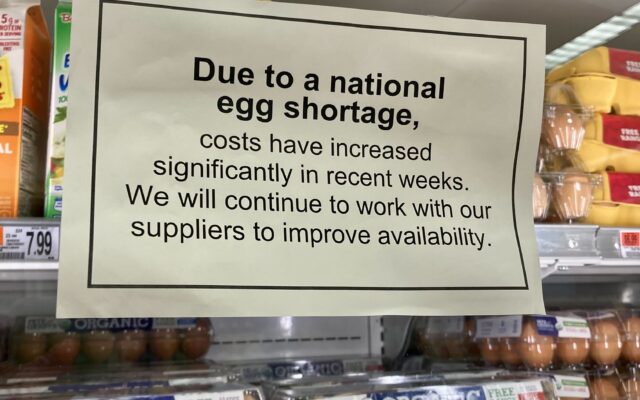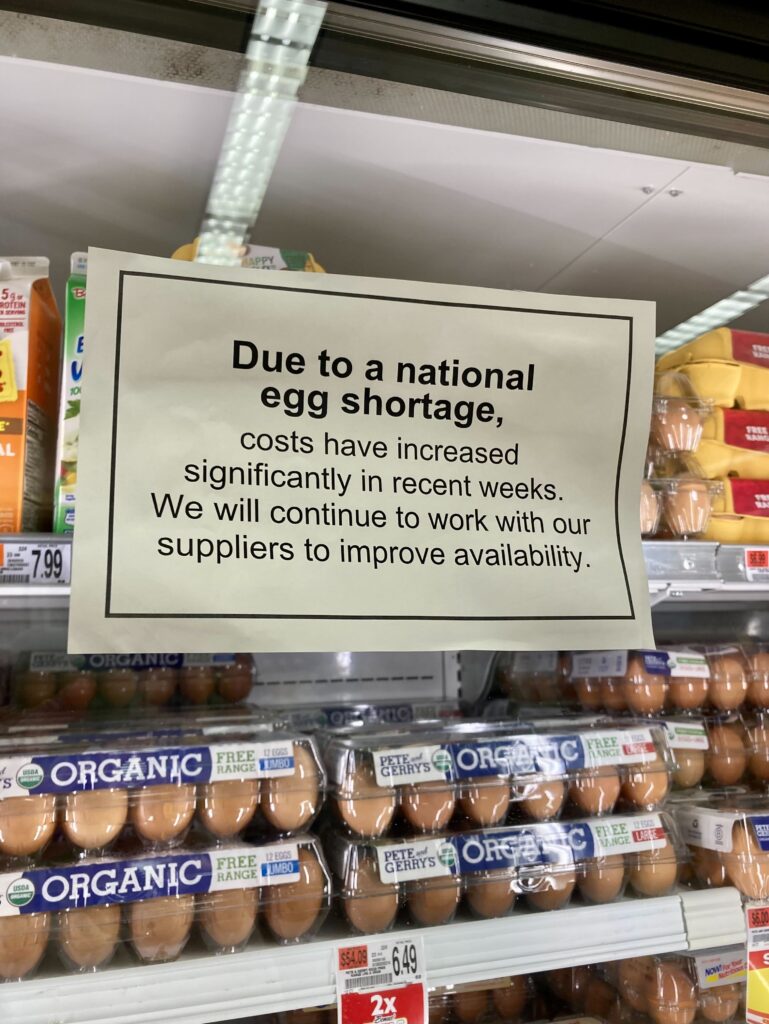
How rising costs hammered Mainers in 2022
By Lori Valigra, Bangor Daily News Staff
Consumers are feeling the pinch of product shortages and rising prices as they head into the holidays.
Most goods and services needed around the house, from eggs to housing payments, rose starkly since the beginning of the year. Others, like milk, kept pace with inflation, which stands at 7.7 percent. There are a few situations where prices have decreased because of a strong supply of goods, including many televisions.
Here are top consumer goods and services and how prices have changed since the start of 2022.
191 percent for eggs
That is the increase for a dozen large, brown eggs in Maine. That has almost tripled since the beginning of the year because of a combination of inflation, product shortages and the impact of bird flu.
The price rose from $1.70 per dozen on Jan. 4 to $4.95 per dozen on Dec. 20, according to the U.S. Department of Agriculture.

EGG PRICES — This sign greeted customers at the egg display at Shaw’s Supermarket in Dover-Foxcroft on Oct. 10.
Up to 49 percent for electricity
Electricity rates for both major suppliers, Central Maine Power and Versant Power, will rise sharply starting Jan. 1.
A November rate increase approved by the regulatory Maine Public Utilities Commission for the electricity supply, which is reached by a competitive bidding process, would take CMP’s supply rate up 49 percent to 17.63 cents per kilowatt hour.
Versant’s supply rate will rise 41 percent to 16.4 cents per kilowatt hour. That means the total bill for the average CMP residential customer will rise 26 percent to nearly $155 per month and for Versant customers it will rise 21 percent to nearly $139.
27 percent for rent in Bangor
Rent for a one-bedroom apartment in Bangor — $700 per month as of mid-December — was up from one year ago, but prices are on the decline compared with a month ago, according to the price-tracking website Zumper.
A one-bedroom Queen City apartment was down 20 percent from November, while a two-bedroom apartment was down 6 percent to $1,200 monthly and a studio was down 16 percent over the month to $675.
23 percent or more for heating oil
The average statewide price for heating oil rose to $4.53 per gallon on Dec. 19, up from $3.67 on Jan. 1, according to the Governor’s Energy Office.
The U.S. Energy Information Agency predicts that costs for nearly all home heating methods will remain high this winter, stemming from continued global energy market volatility following Russia’s invasion of Ukraine. Heating aid for low-income Mainers continues to be stretched thin.
11 percent for homes
Prices for single-family homes in Maine continue to climb, despite fewer sales related to tight inventory. The median sales price for a single-family home was $292,250 in January, which rose 11 percent to $325,000 in November, according to data released Wednesday by the Maine Association of Realtors.
8.5 percent to eat out
The cost to eat food away from home rose 8.5 percent nationally over the past year. But that is less than the 12 percent rise to buy food and eat it at home, according to the U.S. Bureau of Labor Statistics. High grocery prices are making it cheaper to eat out for certain dishes, a turn from the usual cooking at home to save money.
A New York Post analysis found some meals, like the egg-pasta-bacon dish served at the Cheesecake Factory, are a few dollars less to cook at home. Others, like Chili’s baby back ribs, cost about $6 more, mainly because spices for the dish cost more than $15, with spice, seasoning and condiment prices up 14 percent this year.
7 percent for milk
The price increase for a gallon of whole milk at a retail store in Maine. Milk was $4.10 on Jan. 2 and rose at about the same rate of inflation to $4.49 on Dec. 4, according to the Maine Milk Commission.
1 percent for gas
The statewide average for a gallon of regular gas is almost down to what it was one year ago, which is good news for holiday travelers. Prices have been declining since last month’s $3.89 average to $3.45 on Dec. 21, according to AAA. The price was $3.42, less than 1 percent lower, one year ago.
TVs down 17 percent
The average television nationwide is less expensive than it was a year ago, according to the October Consumer Price Index. That’s an outlier compared with almost every other consumer good. Part of the reason is that manufacturers responded to renewed demand from housebound consumers early in the pandemic, with a ready supply leading to price decreases, industry analysts told CNBC.